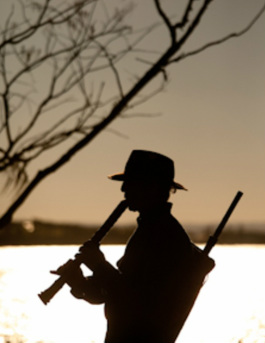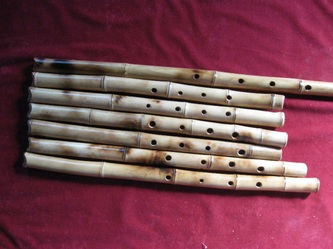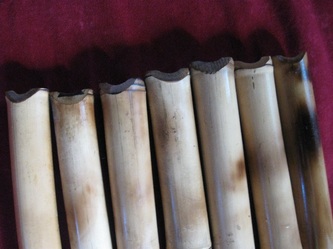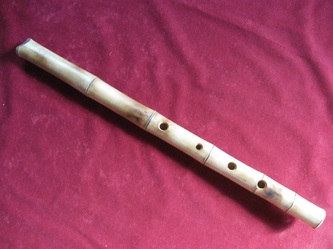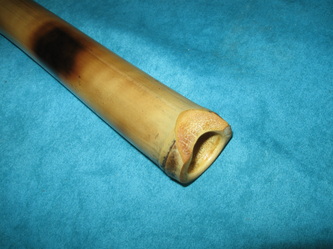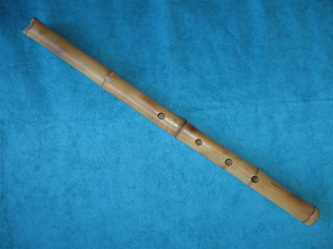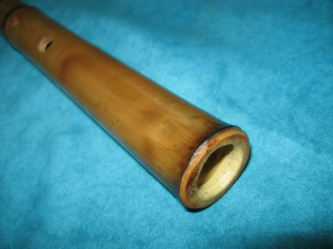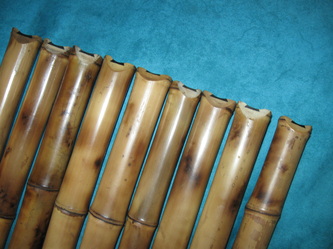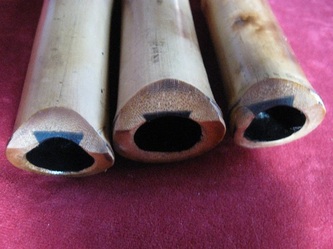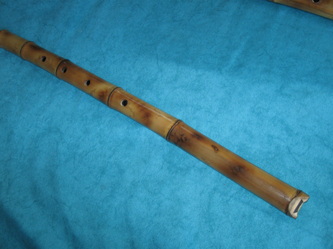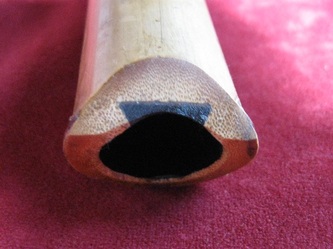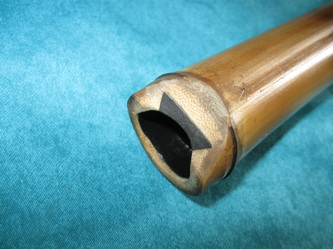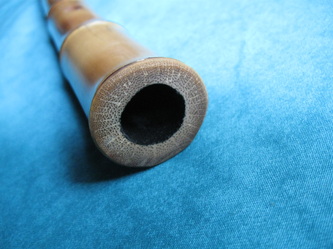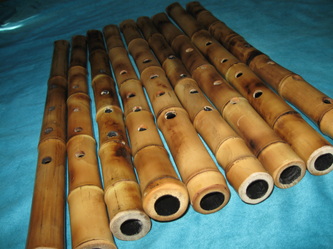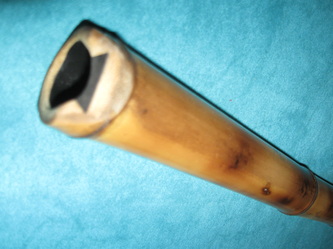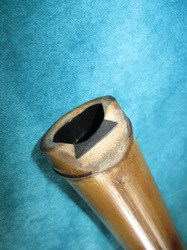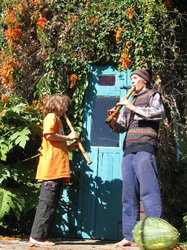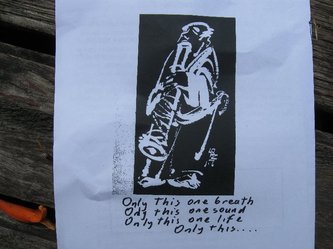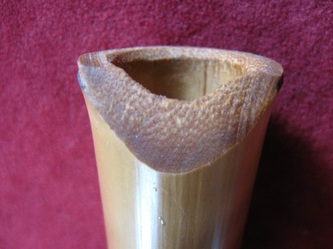Shakuhachi Natural Bore |
Add $10 for worldwide postage
|
Inlaid Shakuhachi |
---- Shakuhachi Flute ----
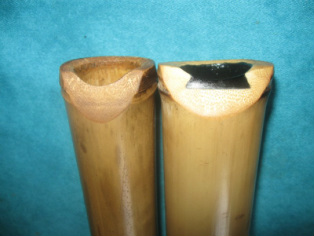
" Thanks for sending the flute, I think it is fine flute for beginners. ".....Bronwyn Kirkpatrick, Shakuhachi Master and teacher , Katoomba ,Australia http://www.bronwynkirkpatrick.com/
Famous for it's beautiful haunting tones,this end-blown flute captivates many when they first hear it played.
Though its origins seem unclear ,it is known that the shakuhachi came from China to Japan where it is historically connected to the Zen monasteries and the Fuke sect (The Priests of Nothingness). Even today its sound invokes in many a longing for or remembrance of a deeper connection to the natural world.
The Shakuhachi is often regarded as being 'challenging' (I don't like to use the word "difficult') to play.....For some this is a drawback , for others an enticement. As I often say to people at my stall "You have to do something with your life , you might as well learn the shakuhachi flute".......It's definitely one of the better things that I have done with mine........
I have found my journey into the world of the shakuhachi flute has been a journey into unknown depths within myself ....an intimate exploration of the ever more subtle relationship between myself , my flute and the everchanging world around us.
To play the shakuhachi well requires the unusual combination of a high degree of focused attention and very relaxed body to allow for an even flow of breath....not coincidentally a similar combination to those required in many meditation techniques.
I make beginners shakuhachi in the keys of D, C , and A.
All flutes are very accurately tuned and play clearly in two octaves.
Famous for it's beautiful haunting tones,this end-blown flute captivates many when they first hear it played.
Though its origins seem unclear ,it is known that the shakuhachi came from China to Japan where it is historically connected to the Zen monasteries and the Fuke sect (The Priests of Nothingness). Even today its sound invokes in many a longing for or remembrance of a deeper connection to the natural world.
The Shakuhachi is often regarded as being 'challenging' (I don't like to use the word "difficult') to play.....For some this is a drawback , for others an enticement. As I often say to people at my stall "You have to do something with your life , you might as well learn the shakuhachi flute".......It's definitely one of the better things that I have done with mine........
I have found my journey into the world of the shakuhachi flute has been a journey into unknown depths within myself ....an intimate exploration of the ever more subtle relationship between myself , my flute and the everchanging world around us.
To play the shakuhachi well requires the unusual combination of a high degree of focused attention and very relaxed body to allow for an even flow of breath....not coincidentally a similar combination to those required in many meditation techniques.
I make beginners shakuhachi in the keys of D, C , and A.
All flutes are very accurately tuned and play clearly in two octaves.
The shakuhachi is usually taught in D ( also known as the 1.8 in shakuhachi circles ).
There are shakuhachi instruction manuals that come with CD sold online .
In Australia, Bronwyn Kirkpatrick ( located in Katoomba ) and others teach online using Skype .
The C and A flutes are both longer again than the D. The C flute is still a reasonably easy stretch for most people while the longer A flute can be mastered by most though some with smaller hands may find the gap between the holes too long.
I usually offset the holes on the A shakuhachi to make the stretch a bit easier . To do this I need to know which ends of the flute you place your left and right hand .
Lower end of the Aurea bamboo is used to make the flutes with the root end shakuhachis also sometimes available. Email me if interested.
I also can make a seven hole shakuhachi if required . On the D shakuhachi two extra offset holes are placed in the flute ( an E and B notes ) , to give the full chromatic C scale . Email me if interested .
There is the standard beginners model which has a natural bamboo blowing edge and natural bamboo bore that has been sealed with either tung oil or boiled linseed
oil. (See photos below for more detail ) Available in D ,C and A.
Cost : D and C : $125AUD A : $130AUD
plus $10 postage .
I also make a beginners model which have an inlayed ( made from black perspex ) blowing edge and the bore is sealed with quality non toxic acrylic paint. These flutes are usually made from thicker bamboo than the standard beginners model.
( See photos below for more detail ) Available in D and C.
Cost : D and C : $145 AUD. A : $150 AUD
Traditionally a five hole flute (4 in the front and a thumb hole in the rear ) , all flutes are accurately tuned to the minor pentatonic scale . Only flutes that have good tonal qualities and play relatively easily (for a shakuhachi) are sold.
These are good flutes for anyone wanting to take the plunge into the shakuhachi's soothing waters without having to pay lots of money for a high quality flute.
NOTE :All flutes come with a fingering chart and basic playing and care instructions.
For more info and contacts within Australia ,go to the the Australian Shakuhachi Society website at: www.shakuhachi.org.au
There are shakuhachi instruction manuals that come with CD sold online .
In Australia, Bronwyn Kirkpatrick ( located in Katoomba ) and others teach online using Skype .
The C and A flutes are both longer again than the D. The C flute is still a reasonably easy stretch for most people while the longer A flute can be mastered by most though some with smaller hands may find the gap between the holes too long.
I usually offset the holes on the A shakuhachi to make the stretch a bit easier . To do this I need to know which ends of the flute you place your left and right hand .
Lower end of the Aurea bamboo is used to make the flutes with the root end shakuhachis also sometimes available. Email me if interested.
I also can make a seven hole shakuhachi if required . On the D shakuhachi two extra offset holes are placed in the flute ( an E and B notes ) , to give the full chromatic C scale . Email me if interested .
There is the standard beginners model which has a natural bamboo blowing edge and natural bamboo bore that has been sealed with either tung oil or boiled linseed
oil. (See photos below for more detail ) Available in D ,C and A.
Cost : D and C : $125AUD A : $130AUD
plus $10 postage .
I also make a beginners model which have an inlayed ( made from black perspex ) blowing edge and the bore is sealed with quality non toxic acrylic paint. These flutes are usually made from thicker bamboo than the standard beginners model.
( See photos below for more detail ) Available in D and C.
Cost : D and C : $145 AUD. A : $150 AUD
Traditionally a five hole flute (4 in the front and a thumb hole in the rear ) , all flutes are accurately tuned to the minor pentatonic scale . Only flutes that have good tonal qualities and play relatively easily (for a shakuhachi) are sold.
These are good flutes for anyone wanting to take the plunge into the shakuhachi's soothing waters without having to pay lots of money for a high quality flute.
NOTE :All flutes come with a fingering chart and basic playing and care instructions.
For more info and contacts within Australia ,go to the the Australian Shakuhachi Society website at: www.shakuhachi.org.au
The basic beginners shakuhachi above.
Shakuhachi with sealed bore and inlaid blowing edge below
For a larger view of any of the photos just click on it.
Shakuhachi with sealed bore and inlaid blowing edge below
For a larger view of any of the photos just click on it.
"After silence, what comes nearest to expressing the inexpressible is music."
Aldous Huxley
For a few tips for the beginner Shakuhachi Master and to see and hear one of my shakuhachis in D watch the YouTube video below:
Aldous Huxley
For a few tips for the beginner Shakuhachi Master and to see and hear one of my shakuhachis in D watch the YouTube video below:
